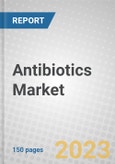This report is focused on newer drugs and innovations in chemical compounds, recently launched or in development. Specifically excluded from the scope of research are vector or mosquito control, drugs used for symptomatic treatment and not for the elimination of the virus from the host and details on manufacturers and suppliers of non-branded generics. This report will also highlight the current and future market potential of antibiotics with detailed analysis of the competitive environment. Drivers, restraints, opportunities, pricing analysis, impact of COVID-19, other infectious diseases and a regulatory scenario assessment are covered, along with a market projection for 2027 and market share assessment for key players.
The report segments the market for antibiotics based on product type, route of administration, application and geographical region. Based on product type, the market is segmented into cell wall inhibitors, protein inhibitors, DNA and other inhibitors (RNA, mycolic acid, folic acid). Based on route of administration, the market is segmented into oral and topical.
By geographical region, the market has been segmented into North America, Europe, Asia-Pacific, South America and the Middle East and Africa. Detailed analysis of major countries (U.S., Germany, UK, Italy, France, Spain, Japan, China, India, Brazil, Mexico, GCC countries and South Africa) will be covered in the regional segment. For market estimates, data will be provided for 2021 as the base year, with estimates for 2022 and forecast value for 2027.
Report Includes
- 22 data tables and 16 additional tables
- An overview of the global market for antibiotics within the pharmaceutical industry
- Analyses of the global market trends, with data corresponding to market size for 2019-2022, estimates for 2023, and projections of compound annual growth rates (CAGRs) through 2027
- Information on market growth drivers and opportunities, industry supply chain structure, regulatory developments, technological advancements, and demographic shifts shaping the overall antibiotics marketplace
- Evaluation of market growth during the forecast period, and deep dive of market share analysis data basis of product type, product, route of administration, end-user, and geographical region
- Country specific data and analysis for the U.S., Germany, the U.K., Italy, France, Spain, Japan, China, India, Brazil, Mexico, GCC countries and South Africa
- Identification of the companies best positioned to meet the global market demand for antibiotic drugs on the basis of their proprietary technologies, M&A deals, collaborations, JVs and other strategic alliances
- Company profiles of major players within the industry, including Abbott, F. Hoffmann-La Roche AG, Merck & Co. Inc., Pfizer Inc. and Sanofi
Table of Contents
Executive Summary
The global market for antibiotics was valued at $39.2 billion in 2021. The market is expected to grow at a compound annual growth rate (CAGR) of 4.2% to reach $49.6 billion by the end of 2027. The antibiotic market growth outlook is positive with significant growth potential for cell wall inhibitor and protein inhibitor antibiotic drugs. There is pressure on antibiotic drug manufacturers to offer antimicrobialresistant drugs at affordable prices. At the same time, factors such as rising disposable incomes and increasing spending on healthcare in emerging markets, increasing grants from government agencies for antibiotic drugs R&D and rising incidence of infectious diseases are contributing to the growth of the market.
Pharmaceutical companies and governments are increasingly working together in partnerships and collaborations to provide funding and to implement incentive programs for the R&D of antibiotics. These partnerships provide financial and technical assistance across different clinical development phases. Various programs, such as the Joint Programming Initiative on Antimicrobial Resistance (JPIAMR), the Innovative Medicines Initiative’s (IMI’s) New Drugs for Bad Bugs (ND4BB) program, Biomedical Advanced Research and Development Authority’s (BARDA) Broad Spectrum Antimicrobials Program and Combating Antibiotic Resistant Bacteria Biopharmaceutical Accelerator (CARB-X), have been implemented for the development of novel antibiotics by focusing on R&D gaps.
Additionally, The Davos Declaration was signed in Jan. 2016 by more than 100 companies and trade associations (Allergan, AstraZeneca, GSK, Pfizer and Sanofi). This declaration focused on investments in R&D to meet public health needs, reducing the development of antimicrobial resistance and improving access to antibiotics.
Pharmaceutical companies are increasingly adopting 3D printing technology for the discovery and development of new antibiotics to reduce manufacturing costs and increase production efficiency. In 2018, a 3D-printed fluorescence imaging box (PFIbox) was developed by McMaster University’s laboratory for antibiotics discovery. This box is capable of analyzing more than 6,000 samples of bacteria at a time and provides vital information on bacterial response.
The global antibiotic market is segmented based on the product, route of administration, end user and region.
Companies Mentioned
- Abbott
- F. Hoffmann-La Roche AG
- GlaxoSmithKline plc
- Johnson & Johnson
- Merck & Co. Inc.
- Pfizer Inc.
- Sanofi
- Viatris Inc.
Table Information
| Report Attribute | Details |
|---|---|
| No. of Pages | 150 |
| Published | May 2023 |
| Forecast Period | 2022 - 2027 |
| Estimated Market Value ( USD | $ 40.4 Billion |
| Forecasted Market Value ( USD | $ 49.6 Billion |
| Compound Annual Growth Rate | 4.2% |
| Regions Covered | Global |
| No. of Companies Mentioned | 8 |









